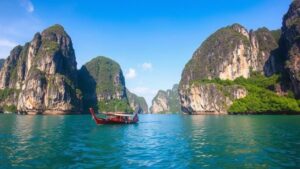Exploring the dense mangroves of Madagascar for remnants of an unknown maritime civilization.
Exploring the Dense Mangroves of Madagascar for Remnants of an Unknown Maritime Civilization
Madagascar, the fourth largest island in the world, is renowned for its rich biodiversity and unique ecosystems. Among its most intriguing habitats are the dense mangroves lining its coastal areas, which harbor secrets and stories yet to be uncovered. Recent explorations suggest these mangrove regions may hold remnants of an unknown maritime civilization, challenging conventional historical narratives and illuminating the islands past.
The Significance of Madagascars Mangroves
Madagascars mangrove forests, covering approximately 470,000 hectares, represent crucial ecological zones. serve as nurseries for a variety of marine life and play a vital role in coastal protection, biodiversity preservation, and carbon storage. But, their dense canopies also obscure artifacts and traces of human history, possibly linked to maritime cultures that thrived long before recorded history.
Historical Context
While Madagascar is often studied through the lens of Austronesian and African colonization, recent archaeological findings suggest that these mangroves may hide the remnants of a maritime civilization that predates these known cultures. The islands coastal areas were significant pathways for ocean-going trade, connecting the African continent with Asian and Polynesian cultures since at least 500 AD. As researchers delve into the mangrove ecosystems, they are piecing together the narrative of these forgotten societies.
- The first Austronesians arrived around 1,500 years ago, bringing with them seafaring knowledge and agricultural practices.
- Maritime trade routes during this period were highly developed, with evidence of exchange networks spanning from the East African coast to the islands of Southeast Asia.
Recent Discoveries and Their Implications
Recent archaeological surveys, particularly around the Menabe region in western Madagascar, have unearthed tools and artifacts that provide insight into the potential maritime practices of ancient communities. Researchers focusing on sediment core analysis and underwater archaeology have reported the discovery of:
- Stone tools dated back to 1,000-1,500 years, indicating advanced craftsmanship and potential trade networks.
- Remains of ancient vessels, which suggest the development of boat-making technologies suited for the mangrove-lined coast.
These findings raise questions about the adaptability and ingenuity of early inhabitants, who learned to navigate the often-treacherous coastal waters while utilizing their mangrove environments.
Challenges and Future Exploration
Exploring the dense mangroves of Madagascar poses significant challenges. The thick vegetation and muddy terrains complicate archaeological digs, and the rapid degradation of these ecosystems due to climate change and deforestation further threaten the integrity of historical sites. But, advanced technologies such as LiDAR (Light Detection and Ranging) and remote sensing hold promise for uncovering hidden structures beneath the foliage.
- LiDAR can penetrate dense canopies, allowing researchers to map the topography and identify potential settlement sites without disturbing the environment.
- Collaborative efforts with local communities can help protect these sites while encouraging sustainable practices that respect both the ecosystem and cultural heritage.
Real-World Applications and Significance
The exploration of Madagascar’s mangroves as potential sites of former maritime civilizations not only enriches our understanding of human history but also emphasizes the importance of preserving these vital ecosystems. The findings could reshape our views on cultural exchange in the Indian Ocean and regard Madagascar as a significant player in ancient maritime trade.
Also, recognizing the historical and ecological significance of mangroves can promote conservation efforts, benefiting local communities that rely on these ecosystems for their livelihoods.
Actionable Takeaways
Exploring Madagascar’s mangroves offers a window into a potentially rich maritime past. Here are some takeaways for those interested in this field:
- Support or engage in local conservation initiatives aimed at protecting mangrove ecosystems.
- Stay informed about ongoing archaeological surveys and their findings; public interest can help elevate the importance of these studies.
- Consider the broader implications of historical research on modern ecological and economic practices.
The ongoing investigations into Madagascars mangroves are more than just an archaeological pursuit; they are an invitation to appreciate the interconnectedness of history, culture, and ecology.


